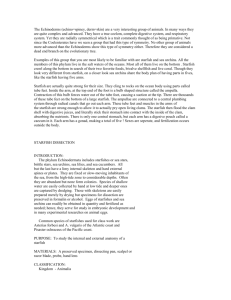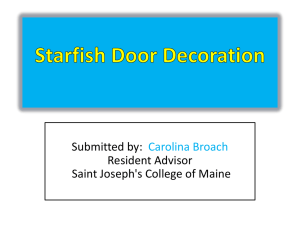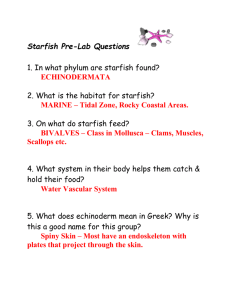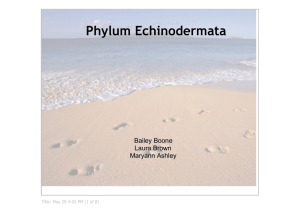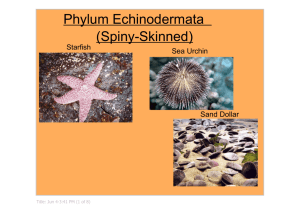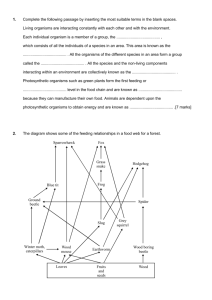A Miniguide to the Dissection of the Starfish
advertisement
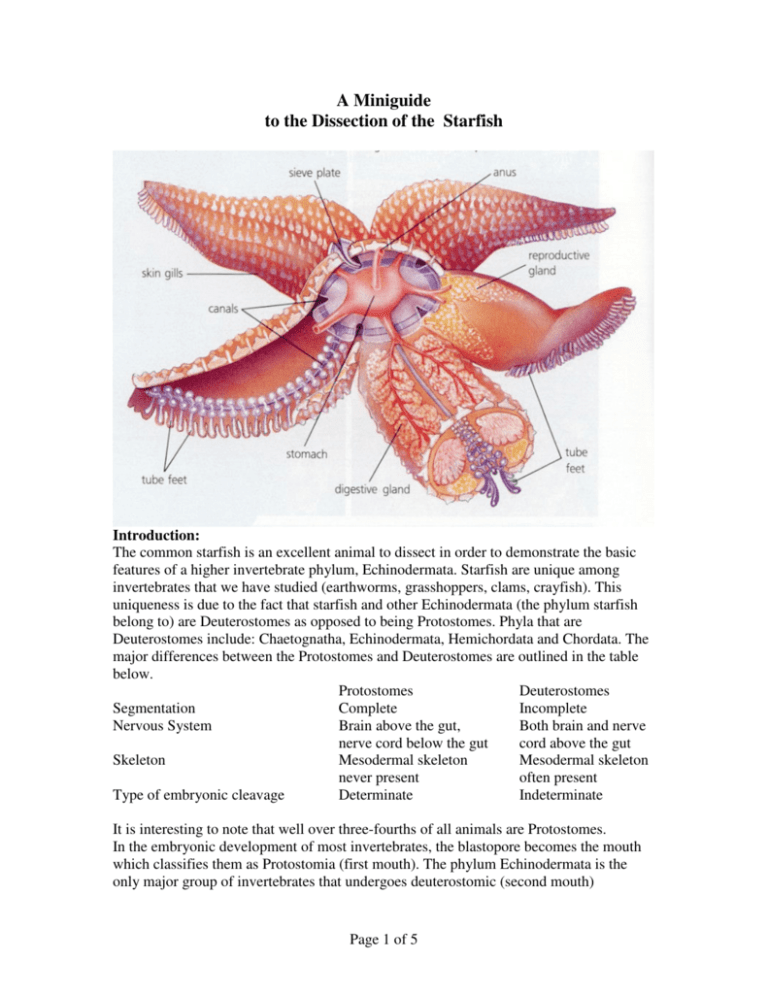
A Miniguide to the Dissection of the Starfish Introduction: The common starfish is an excellent animal to dissect in order to demonstrate the basic features of a higher invertebrate phylum, Echinodermata. Starfish are unique among invertebrates that we have studied (earthworms, grasshoppers, clams, crayfish). This uniqueness is due to the fact that starfish and other Echinodermata (the phylum starfish belong to) are Deuterostomes as opposed to being Protostomes. Phyla that are Deuterostomes include: Chaetognatha, Echinodermata, Hemichordata and Chordata. The major differences between the Protostomes and Deuterostomes are outlined in the table below. Protostomes Deuterostomes Segmentation Complete Incomplete Nervous System Brain above the gut, Both brain and nerve nerve cord below the gut cord above the gut Skeleton Mesodermal skeleton Mesodermal skeleton never present often present Type of embryonic cleavage Determinate Indeterminate It is interesting to note that well over three-fourths of all animals are Protostomes. In the embryonic development of most invertebrates, the blastopore becomes the mouth which classifies them as Protostomia (first mouth). The phylum Echinodermata is the only major group of invertebrates that undergoes deuterostomic (second mouth) Page 1 of 5 development, in that the embryonic blastopore becomes the anus and the "second mouth" forms as a new opening. This embryological evidence indicates that the phyllum Chordata (subphyla: Cephalochordata, Urochordata and vertebrate) evolved from the Echinodermata, as this is the only invertebrate phylum with deuterostomic development. The phylum Echinodermata is composed of the most familiar marine animals and is distinguished by (1)pentamerous radial symmetry, (2) a calcareous endoskeleton with projecting spines, and also (3) a system of coelomic canals and tube feet (the watervascular system) that is used in slow locomotion and manipulation of food. Possession of a system of coelomic canals differentiates the Echinoderms from their earlier acoelomic ancestors, the flatworms (phylum Platyhelminthes). The echinoderms are divided into two subphyla. The subphyllum Pelmatozoa contains one class, Crinoidea (sea lilies). The second subphyllum, Eleutherozoa, contains four classes: Ophiuroidea (brittle stars), Holothuroidea (sea cucumbers), Echinoidea (sea urchins and sand dollars), and Asteroidea (starfish). The unifying features of the class Asteroidea include 1) a star-shaped body with multiples of five radially symmetrical arms that are not sharply set off from the central disk and 2) the water-vascular system. The starfish utilized in this dissection exercise is of the order: Forcipulata, family: Asteriidae, and genus: Asterias or Pisaster. About 1700 species of starfish have been described living in marine coastal waters from the north to the south poles. An interesting characteristic of Asteroids is the ability to completely regenerate a whole organism from only one fifth of the central disk that has at least one arm remaining attached. Regeneration is slow, requiring up to a year for complete reformation. Attention to the details of the dissection procedure along with reading each section of this manual before you proceed will help you to avoid damaging the starfish specimen. In order to perform the dissection the following tools are recommended: 1. Dissection scissors 2. Forceps 3. Scalpel 4. Dissecting needle In order to keep your specimen moist during dissection, we recommend that the specimen be sprayed with Delta-sol, a non-toxic odorless liquid that preserves the tissue and is nonirritating to the skin; see our catalog for details. External Features The opening of the water-vascular system, the madreporite, is a large button-like structure that is located off center on the disc between two arms. The inconspicuous anus is in the center of the disk, and both structures are located on the upper, dorsal or aboral surface of the starfish. Page 2 of 5 The mouth is in the center of the underside, ventral or oral surface of the starfish body. On the oral surface of each arm are open ambulacral grooves extending from the mouth to the tip of each arm. These deep furrows contain two or four rows of tube feet, podia, with protruding suckers; features unique to the echinoderms. At the end of each arm or ray is an eyespot containing red pigment which allows the starfish to sense and respond to light. In preserved specimens, the eyespot can be located with a magnifying glass or dissecting scope by spreading the tube feet at the tip of the ray. The aboral surface of the starfish is an arrangement of calcareous plates or ossicles of endoskeleton (internal skeleton) that allow both lateral and up and down movement (see detail Figure 1) Numerous spines protrude from the surface of the endoskeleton and give the body a warty or spiny appearance, hence the name echinoderm--spiny skin. Using a magnifying glass or dissecting scope, it can be seen that the movable spines are covered with a thin layer of epidermis. The spines are an adaptation for the burrowing existence of many starfish. surrounding the spines, forming a collar-like ring, are the small finger-like processes, dermal branchiae. These thin-walled structures are the major surface in contact with the aquatic environment, and they therefore function in respiration. In addition, small jaw-like pincers, or pedicellariae, rise from the surface for use in food handling and for protection against small larvae or animals that settle on the starfish. Beginning the Dissection. We will study the skeletal, digestive, reproductive, water-vascular, and nervous systems. Skeletal: Cut one arm off your specimen and study the cross section of the stump. Note that the cavity in the arm is an extension of the body coelom. Make a cut up the side of the severed arm and then across the top to allow you to open the body wall and view the structure and pattern of the inner skeletal framework. Observe the network of the ossicles in the aboral, or dorsal surface and sides of the body wall. The largest ossicles, ambulacral ossicles, support the ambulacral groove and provide attachment for the tube feet. Digestive: Sever the tip from an undissected arm and then cut up each side of the arm towards the disk. Carefully raise the body wall, disconnecting the mesenteries of connecting tissues that attach the internal organs to the wall. Cut across the aboral surface where the arm joins the disk. Just under the dorsal endoskeleton are located large paired organs, hepatic ceca (Figures 1,3). There are a pair in each arm and they function as secretory glands to aid indigestion which involves eversion of the stomach and external digestion. Continue to cut along the edges of at least three of the arms, two of which should be on either side of the madreporite. Also cut along the outer edge of the disk, and around the madreporite. Carefully remove the upper surface, separating the organs from the internal surface of the body wall by clipping the mesenteries, but leaving the madreporite intact. Trace the connection between the hepatic ceca and the disk, the hepatic ducts, which all secrete into the small aboral pyloric stomach. Dorsal, or above the pyloric stomach is a small pair of lobed rectal ceca, which function in waste consolidation before excretion through the hard to see anus. Underneath, or ventral to the pyloric stomach is the large, Page 3 of 5 baglike cardiac stomach, which protrudes through the mouth while feeding. The everted stomach engulfs the prey and can insert itself into a slit in a shellfish only 0.1 mm wide. Digestion can begin outside the body until the cardiac stomach is retracted by five pairs of retractor muscles, one pair in each arm. Each of the structures mentioned here can be identified in Figure 1. Reproductive: Starfish are dioecious, meaning the sexes are separate, though the location and number of gonads is the same in both sexes. Remove the digestive system by lifting the pyloric ceca from the arms and by cutting through the 10 retractor muscles to the stomach, two from each arm. Now snip out the stomach at its opening to the oral surface, the mouth. This will reveal pairs of gonads in each arm, lying under the hepatic caeca, alongside the ambulacral groove, and yet close to the disk (Figures 1,3). The size of the gonads depends upon the phase of the breeding cycle at the time the specimen was collected. The gonads are branched lobulaled sacs that open to the exterior by small genital pores located on the periphery of the aboral disk (Figure 1). Eggs and sperm are released into the sea where fertilization takes place. Because the starfish can regenerate individuals from fragments, and thus increase the population, regeneration is a form of asexual reproduction. Water-vascular: The water-vascular system is an internal water pressure system. Water enters the system through the sievelike madreporite in the aboral surface and passes through the stone canal into the ring canal which encircles the mouth. Nine sacs, Tiedemann's bodies, are located on the inner edges of the ring canal. These sacs are the breeding grounds of amoeboid cells that are found in the fluid of the water-vascular system. Find these 3 structures in Figure 4 and in your specimen. Extending out from the ring canal are five radial canals, one into each arm. Lying in the groove of the dorsal side of the ambulacral ossicles is the radial canal. It is best seen by applying slight pressure to separate the ossicles so that one can see into the groove, or in cross section of a severed arm. At regular intervals lateral canals branch off the radial canal and lead to muscular bulbs, ampulla, as well as opening to the tube feet (Figures 1,2,3). The ampullae are obvious rows of buff-colored sacs along both sides of the ambulacral ossicles. Continue dissecting the ambulacral ossicles of an arm to locate the lateral canals that lead to the ampulla. The tube feet are about 1 cm long, and at the tip of each is a sucker. The ampulla contracts and water is forced into the tube foot, extending it and enabling it to attach to the substratum with its sucker. The muscles of the foot then contract and force water back into the ampulla, thus shortening the foot. Valves and reservoirs within the water-vascular system control the internal pressures that operate the tube feet for stow locomotion and remarkable, prolonged sucking action that opens oysters and clams for food. The starfish is therefore considered to be a problem to the shellfish industry. Nervous: Nerves coordinate the arm movements for directional locomotion of the starfish. The nerves are difficult to discern during dissection, so we will discuss them only briefly. There is an oral nerve ring around the mouth from which extends five radial nerves along the ventral side of the ambulacral grooves, one into each arm. The arm movement is coordinated by ganglion cells located at the junction of each radial nerve Page 4 of 5 and the oral nerve ring. Other local nerve centers control the stomach, tube feet and ampulla. A network of nerves in the body wall controls the structures on the external surface of the starfish. These structures are not noted in the figures. There is a non functional blood-vascular or hemal system present in starfish. Circulation of coelomic fluids is accomplished by the action of cilia that line the body cavity. The entire hemal system consists of an axial sinus located near the stone canal and a hemal ring with branching radial hemal canals into the arms. These structures are not noted in the figures. Natural History. Starfish are mainly coastal animals, being most numerous in tropical waters associated with coral reefs. Some species have been collected at ocean depths of up to 6000 meters. Starfish range in color from yellow and orange to red, blue and brown. The number of arms may reach as high as 50 in some species. Starfish are predaceous, feeding on any animal inhabitant of the seashore waters that the starfish can swallow or engulf such as mollusks, worms, Crustacea, fish and other echinoderms. The pull of the tube feet is used to open clams and oysters and then the prey is engulfed by the protruded stomach. Starfish may be pests to the shellfish industry, but they are treasures of the sea to the beachcomber. Page 5 of 5

